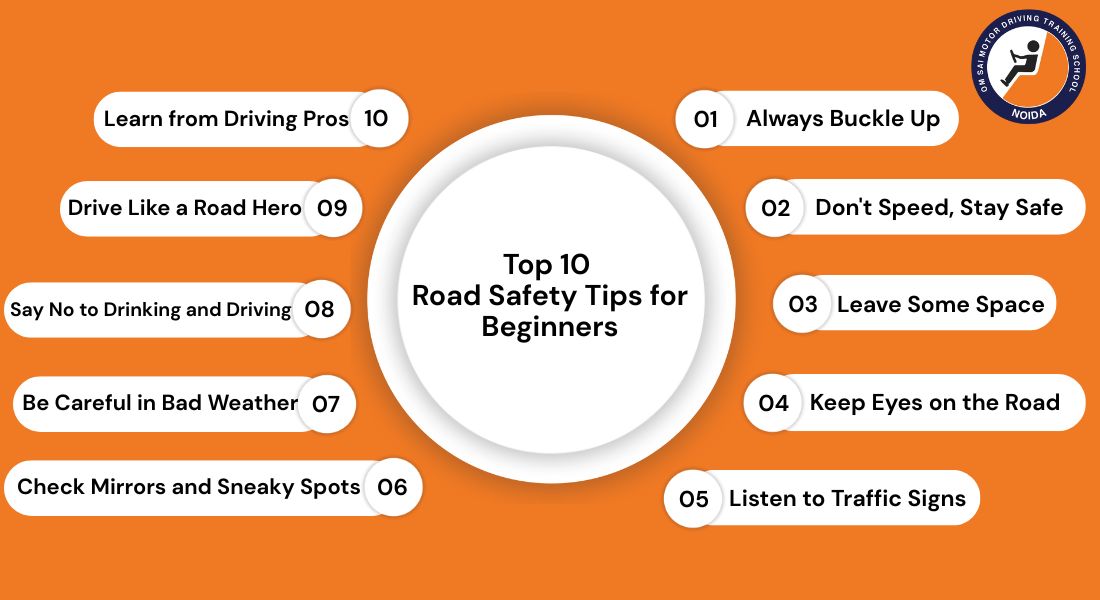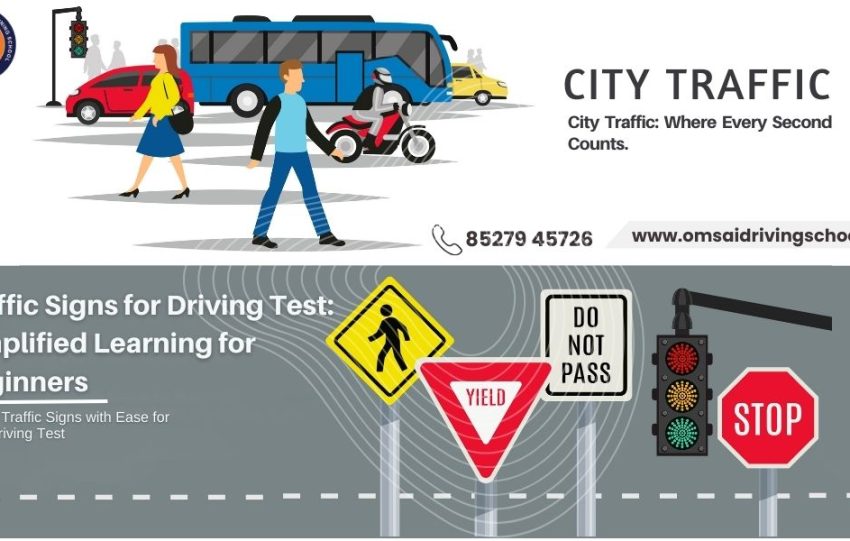Road safety is an important topic that everyone should understand, whether it is for you or passengers. Accidents can happen anywhere, but we can avoid them by following certain road safety rules. Drivers as well as those who want to learn to drive or are learning it is important for everyone to know certain road safety rules, this can save not only your life but also others’ lives. Let’s discuss those top 10 road safety tips
1. Always Buckle Up
Seat belts are a driver’s best friend. They keep everyone safe in the event of a crash or sudden stop. Before starting the car, ensure that every passenger has clicked their seatbelt into place. It should lie flat across the chest and lap, not twisted or loose. Seatbelts hug people tightly to prevent them from getting hurt. For new drivers, buckling up every single time is a must. Even for a quick trip to the store, never skip this step. It’s the easiest way to stay safe and show you care about everyone in the car.
2. Don’t Speed, Stay Safe
Speed limit signs are like friendly reminders for safe driving. They indicate that driving at a slower speed is acceptable in areas such as school zones, neighborhoods, or highways. New drivers should watch for these signs and adjust their speed accordingly. Driving too fast makes it hard to stop or turn, leading to trouble. Use the car’s speedometer to stay on track. If other drivers zoom by, let them go—don’t race. Sticking to the speed limit keeps the vehicle under control and makes the Road a safer place for everyone.
3. Leave Some Space
Keeping a safe distance from the car in front is super important. This space gives time to stop if the other car slows down or stops fast. A cool trick is to stay two seconds behind. Pick a tree or sign, and count “one-two” after the car ahead passes it. If it’s too close, ease off the gas a bit. For beginners, this might feel new, but it’s a game-changer. Leaving a gap stops rear-end bumps and gives new drivers more time to react.
4. Keep Eyes on the Road
Distractions are a big no-no when driving. Things like texting, eating, or changing songs can steal focus from the Road. New drivers should concentrate solely on driving. Need to answer a text or grab a snack? Pull over to a safe spot first. Tuck the phone away in a bag so it’s not tempting. Staying focused helps spot things like a dog running out or a car braking suddenly. Driving is like a mission—keep your eyes and brain locked on the Road to stay safe.
5. Listen to Traffic Signs
Traffic signs and lights are like road coaches. They instruct drivers on when to stop, proceed, or slow down. Stop signs, red lights, yield signs, and road lines have clear jobs. New drivers should learn what they mean and follow them every time. For example, a red light means stop completely, and a yield sign means let others proceed first if necessary. Ignoring signs can cause mix-ups or crashes. Practice spotting them on drives and always follow their instructions. Following the signs keeps the Road smooth and safe.
6. Check Mirrors and Sneaky Spots
Mirrors are valuable for seeing around the car, but miss some areas. New drivers should frequently check the side and rearview mirrors to be aware of their surroundings. Blind spots are tricky places where mirrors can’t show, so turn your head to check them before turning or changing lanes. For example, glance over your left shoulder to see the left side. Checking mirrors and blind spots helps prevent crashes involving bikes, cars, or pedestrians. Make it a quick habit every time a move is planned—it’s like a safety superpower.
7. Be Careful in Bad Weather
Rain, fog, or snow can make driving feel like an adventure, but not fun. Wet or icy roads are slippery, and it’s harder to see. New drivers should slow down and turn on their headlights so others can spot the car. Leave ample space for other vehicles, as stopping takes longer. Use wipers to keep the windshield clear. Avoid making sudden turns or stops, as this can cause the car to slide. Check the weather before going out so you know what to expect. Driving smart in bad weather keeps everyone safe and steady.
8. Say No to Drinking and Driving
Alcohol and some drugs are driving’s worst enemies. They slow down their thinking, blur their vision, and lose control, making crashes more likely. New drivers need to know that even a tiny bit is too much. Plan a safe way home if you’re hanging out with friends, such as having a sober driver or using a ride-sharing app. Never ride with someone who’s been drinking or using drugs. Staying clear-headed behind the wheel keeps drivers, friends, and others safe. This rule is a promise to everyone on the Road.
9. Drive Like a Road Hero
Defensive driving is like being a road superhero. It means being aware of what others might do, such as swerving or not stopping. New drivers should expect mistakes from others and be prepared to respond accordingly. For example, if a car’s too close behind, stay calm and let it pass when it’s safe. Look far ahead for hints, like a ball in the street, which might mean a kid’s nearby. Defensive driving is about staying sharp and thinking ahead to keep the Road safe for all.
10. Learn from Driving Pros
Learning from a great driving school is the best way to start. Excellent instructors teach how to steer, follow rules, and handle tricky moments. They share tips that make driving easier, such as parking without stress or navigating busy roads. Practicing with a pro helps new drivers feel ready for anything. For the best lessons, Om Sai Driving School is a star. With kind and skilled teachers, Om Sai Driving School helps beginners drive safely and confidently, building skills that last a lifetime. It’s the perfect place to kick off a driving journey.
Conclusion
Driving is an exciting adventure, but safety always comes first, especially for beginners. These 10 tips—buckling up, sticking to speed limits, leaving space, staying focused, following signs, checking mirrors, being cautious in inclement weather, avoiding alcohol, driving defensively, and learning from experienced drivers—build habits that keep the Road safe. Practice them every drive to grow confident and careful. With help from experts like Om Sai Driving School, new drivers can hit the Road ready for anything. Start with these tips: keep safety first, and enjoy the ride peacefully.
FAQs
1. What is the most important road safety tip for beginner drivers?
The number one tip is: “Always wear your seat belt.”
According to NHTSA, wearing a seat belt significantly increases your chances of surviving a crash.
Also, avoid distracted driving — stay off your phone and keep your full attention on the road.
2. What is defensive driving, and why is it important for beginners?
Defensive driving means staying alert and being prepared for unexpected actions by other drivers.
It involves maintaining a 3-second following distance, checking your blind spots, and always using turn signals.
This skill helps new drivers avoid accidents and react safely under pressure.
3. What common mistakes should beginner drivers avoid?
Beginner drivers often make these mistakes:
- Speeding
- Not using mirrors properly
- Poor lane discipline
- Failing to check blind spots
- Misunderstanding road signs
Taking proper driving lessons and regular practice can help beginners avoid these common errors.
4. What is the golden rule of road safety?
The golden rule of road safety is: “Drive as you would want others to drive around you.”
This means always being careful, patient, and respectful on the road. Follow traffic rules, stay alert, avoid distractions, and make sure your actions don’t put others in danger. Safety first — for yourself and everyone around you.
5. How to drive a car for beginners?
Here’s a simple guide for beginners learning to drive a car:
Learn the controls: Understand the steering, brakes, clutch, gears, and mirrors.
Start slow: Practice starting, stopping, and steering in an open, safe area.
Follow basic rules: Always wear a seatbelt, obey traffic signals, and stay within the speed limit.
Use mirrors and signals: Check mirrors frequently and use indicators for turning or changing lanes.
Stay calm: Focus on the road, keep both hands on the steering wheel, and drive confidently but carefully.
Practice regularly: More practice will make you better and more comfortable behind the wheel.




